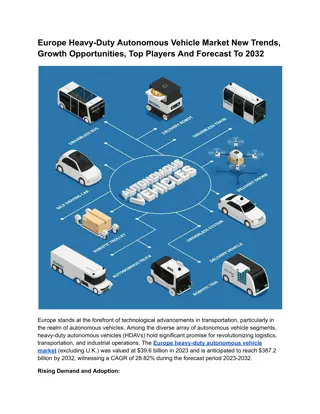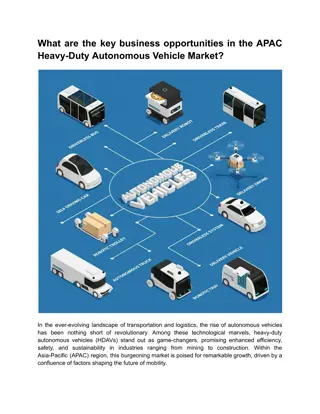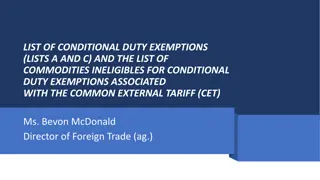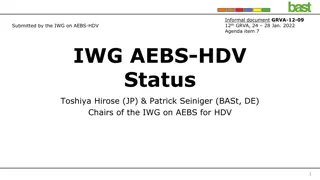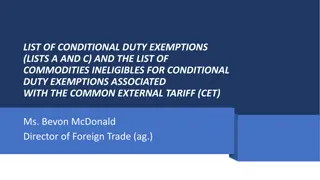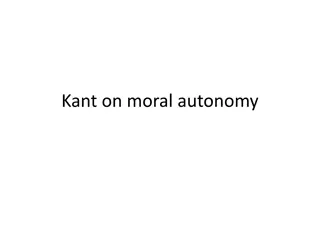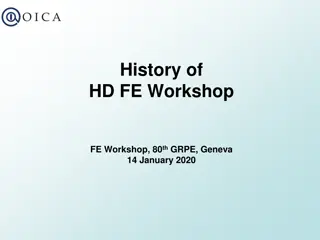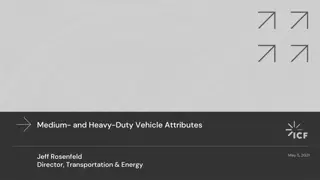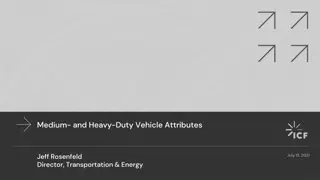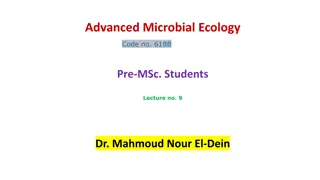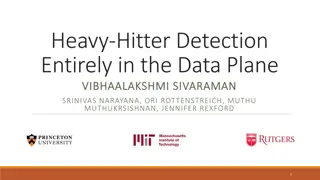Introduction of Heavy-duty Vehicle Energy-saving Standards in China
The China Automotive Technology & Research Center (CATARC) introduced energy-saving standards for heavy-duty vehicles in China. The overview includes the current status of fuel consumption standards for heavy-duty vehicles, future projections, market forecasts, energy conservation challenges, and the guidance document for medium and long-term development plans in the automotive industry. The standards aim to improve fuel efficiency and reduce environmental impact in line with international levels.
Download Presentation

Please find below an Image/Link to download the presentation.
The content on the website is provided AS IS for your information and personal use only. It may not be sold, licensed, or shared on other websites without obtaining consent from the author. Download presentation by click this link. If you encounter any issues during the download, it is possible that the publisher has removed the file from their server.
E N D
Presentation Transcript
Introduction of Heavy-duty Vehicle Energy-saving Standards in China China Automotive Technology & Research Center (CATARC) Jan. 2019 Zheng Tianlei
1 Overall Situation Contents 2 Status quo of FC standards for HDVs 3 Future Work 4 2
Overall Background In recent years, China auto industry develops rapidly, and PCs and CVs both increase at high speed. In 2017, the auto production is 29.01M and sales is 28.88M. Vehicle Sales Volume in China from 2011-2017 15% 4000 3000 10% 416.1 365.1 345.1 379.1 2000 405.5 381.1 403.3 5% 2,471.8 2,437.7 1,970.1 1000 1,792.9 1,549.5 2,114.6 1,447.2 3.0% 0% 0 2011 2012 2013 2014 2015 2016 2017 PV 5.2% 7.1% 15.7% 9.9% 7.3% 15.3% 1.4% growth Rate CV -6.3% -5.5% 6.4% -6.5% -9.0% 5.8% 13.9% 3 Source CAAM
Overall Market Forecast By 2020, sales will exceed 30 million. By 2025, sales will exceed 35 million. Market Scale Forecast in China till 2025 2006-2025 4,000 10000 50% Sales Volume Growth Rate 45.5% 2,803 2,888 2,958 3,080 3,211 3,320 3,420 3,499 3,569 3,629 3,500 40% 3,000 32.4% 2,198 2,349 2,460 2,500 30% 25.4% 1,806 1,851 1,931 21.8% 2,000 20% 1,364 1,500 13.9% 13.9% 938 6.7% 879 1,000 722 6.9% 10% 4.7% 4.3% 4.1% 4.2%3.4% 3.0%2.3% 2.0% 1.7% 500 3.0% 2.4% 2.5% 0 0% 2006 2007 2008 2009 2010 2011 2012 2013 2014 2015 2016 2017 2018F2019F2020F2021F2022F2023F2024F2025F Source CAAM 4
Overall Energy Situation Energy conservation and environmental protection pressure is relatively high, and China s outer dependency for oil rises to 67.4% in 2017, higher than the guard line 50%. 70.0% 65.4% 60.6% 59.6% 58.1% 58.0% 56.5% 60.0% 53.7% 52.0% 49.8% 50.0% 40.0% 2017 inventory hits 30.0% Market vehicles million units of 20.0% 217 10.0% 8.14% 7.92% 5.21% 4.42% 3.27% 2.65% 2.58% 1.68% 0.17% 0.0% 2008 2009 2010 2011 2012 2013 2014 2015 2016 Vehicles with GVW more than 3.5 ton takes up nearly 10%. As high fuel consumption and long annual distance, HDV nearly consumed half of total oil consumption of all vehicles. 5
Overall The Guidance document Medium and Long Term Development Plan(2017) The average fuel consumption for new PCs need to reach the target of 5.0L/100km, CVs approach the international advanced level by 2020 NEVs energy consumption reach international advanced level The average fuel consumption for new PCs need to reach the target of 4.0L/100km, CVs reach the international advanced level by 2020 NEVs energy consumption reach international leading level 6
Overall Standard System Energy consumption label for (light-duty) vehicles Label Limits of fuel consumption for PCs (I~III) Limits of fuel consumption for HDCVs (I) Fuel consumption evaluation methods and targets for PCs (III~IV) Limits of fuel consumption for HDCVs (II) Limits Limits of fuel consumption for LDCVs (I~III) Limits of fuel consumption for HDCVs (III) Fuel consumption measurement methods for LDVs Fuel consumption measurement methods for HDCVs Energy consumption test method for HDVs (HEV) Energy consumption test method for LDVs (HEV) Test Methods Energy consumption and driving range test method for EVs Fuel consumption test methods for CNG vehicles Light-duty Vehicle (M1 M2+N1 3.5T) Heavy-duty Vehicle (M2 M3 N2 N3 3.5T) 7
Status Quo Overall progress Establishing and Implement status in China 2008~ 2010 Items 2011 2012 2013 2014 2015 2016 2017 2018 2019 2020 2021 Establishing Issued in 2011 Test method FC limits (the 1st stage ) Establishing Issued in 2011 FC limits (the 2nd stage ) Establishing Issued in 2014 FC limits (the 3rd stage ) Establishing Issued in 2018 Establishing Implement of vehicle type under producing Implement of new vehicle type 8
Status Quo Vehicle types Apply to vehicles with GVW above 3.5t (except special work vehicle) Industry standard the first stage National standard the second stage Vehicle type Truck Bus Semi-trailer tractor City bus Dumper Special transport vehicle Special work vehicle 9
Status Quo Current test methods FC of HDVS Basic types Variant types Coastdown data or recommended values Engine data Chassis dyno tests Simulation C-WTVC City, rural and highway FC Weighted factors Combined FC 10
Status Quo Current test methods FC of basic types and HEVs could be tested according to chassis dyna testing. FC of variant types could be calculated. Based on the engine data, FC is calculated by inputting resistance and other parameters. Page11
Status Quo Driving Cycle C-WTVC driving cycle, adjusted velocity and acceleration based on WTVC . [b] Weighted factors were determined based on survey data. Vehicle type GVW/GCW City Rural Motorway 9t-25t 0 40% 60% Semi-trailer tractor 27t above 0 10% 90% Dumper 3.5t above 0 100% 0 3.5-5.5t 40% 40% 20% 5.5-12.5t 10% 60% 30% Truck 12.5-25t 10% 40% 50% 10% 30% 60% 25 3.5-5.5t 50% 25% 25% Bus 5.5-12.5t 20% 30% 50% [b] As China do not have driving cycle of HD, thus WHDC was modified and adopted. 12.5above 10% 20% 70% City bus 3.5t above 100% 0 0 P a g e1
Status Quo Phase 3 limits In Feb. 2018, the SAC issued the GB 30510-2018 Fuel consumption limits for heavy-duty commercial vehicles (Phase 3) China proposes that fuel consumption of HDVs will approach the international advanced level by 2020 Feasibility analysis Energy-saving target in 2020 Regulation comparison with US, EU and Japan. Energy saving technology potential analysis Test methods comparison and conversion Energy saving technology costs analysis 13
Status Quo Phase 3 limits The evaluation system is consistent with the Phase 2 limits: the L/100km is taken as the evaluation unit, the fuel consumption limits are determined by different groups based on the GVW. Units Basic parameters System Limits forms Limits for single vehicle types L/100km Stepped limits GVW Corporate averaging L/1000(km t) Linear limits L/1000(km persons) 14
Status Quo Phase 3 limits Trucks (for example) The limits decline 11.5~15.4% to the phase 2 limits. 5.0~16.8% (avg. 9.5%) of current vehicle types can meet the limits. 13.0 14.0 16.0 19.0 21.5 25.0 28.0 31.5 37.5 43.0 45.5 11.5 a 12.2 a 13.8 a 16.3 a 18.3 a 21.3 a 24.0 -14.3% 27.0 -14.3% 32.5 -13.3% 37.5 -12.8% 38.5 -15.4% -11.5% -12.9% -13.8% -14.2% -14.9% -14.8% 3 500 GVW 4 500 4 500 GVW 5 500 5 500 GVW 7 000 7 000 GVW 8 500 8 500 GVW 10 500 10 500 GVW 12 500 12 500 GVW 16 000 16 000 GVW 20 000 20 000 GVW 25 000 25 000 GVW 31 000 31 000 GVW a 1.2 15
Future Work China Cycle(CATC) CATC was issued by MIIT and co-managed by MIIT and other 4 departments. CATARC was entrusted to organize specialists for a three- year deep research. The project investment is closed to 100 million RMB and collected driving data over 50 million km. 1 The driving cycle in current standard is inconsistence with the characteristics of the actual driving condition in China and the differences become larger and larger. 2 Current regulations can t accurately evaluate new technology, such like technologies for new energy vehicle . 2015 2015 2016 2016 2017 2017 Q2 Q2 Q3 Q3 Q4 Q4 Q1 Q1 Q2 Q2 Q3 Q3 Q4 Q4 Q1 Q1 Q2 Q2 Q3 Q3 Q4 Q4 CATC CATC 1 1 3 There are increasingly loud calls for developing China test driving cycle. 2 2 3 3 16
Future Work China Cycle(CATC) On the basis of data analysis, after many discussions with main OEMs, the China cycles for HDVs have been finished City Buses CHTC-B , Buses except City Buses CHTC-C , Trucks GVW 5500kg, CHTC-LT , Trucks GVW 5500kg, CHTC-HT , Dumpers CHTC-D , Semi-trailer-tractors CHTC-S . 17
Future Work Test method revising Test Method Simulation Procedure Cycle ambient conditions testing mass MT shift rules resistance tests payload vehicle family Interface and compatibility improvements CATC Priority CHTC-B City Bus CHTC-C Bus CHTC-D Dumper CHTC-S Semi-trailer Tractors CHTC-LT Truck 3.5t~5.5t CHTC-HT Truck >5.5t) Basic Test Algorithm adjustment Discussing Special Test Basic tests AC ON Low Temp. High alt. Aggressive driving Special vehicles for transportat ion Special vehicles for operating Trucks Bus Semi- trailer Tractors Dumper City bus Trailer 18
Future Work schedule 202X 2019-2021 Phase 3 limits implements 2025 Phase 4 limits implements Phase 4 limits establish based on new method New method implements for new vehicle types 202X Other influences (like China 6 pollutant standards) 2020-2021 New method issues New method implements for all vehicle types 19
THANK YOU. Thanks for listening 20




